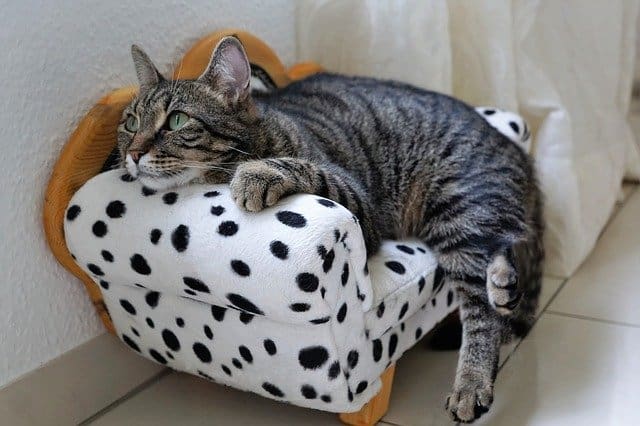
A cat with a cold is evident with a series of symptoms that affect the respiratory system of cats and that presents pictures of coughing, sneezing and secretions from the upper tract.
Feline flu is a broader term that encompasses the most common respiratory diseases in felines.
Keep reading to learn more about this topic, it may be interesting for you.
Causes of a cold in cats
Behind the visible symptoms of a cat cold, there may be different factors that are responsible for the inflammation of the respiratory system in kittens. Let’s see them:
Viral factors
When we talk about feline flu, in general, we are talking about an infection in the respiratory system of a cat, which can be caused by viruses such as Herpesvirus and present in the form of a cold. The Calicivirus, also can manifest as cold and sometimes, can join with bacterial processes, which can complicate the infectious process, especially in cats with impaired health.
A good vaccination status for your cat provides immunity against these two common viral causes.
However, there are two more common bacterial strains that may be present in infectious processes:
- Bordetella bronchiseptica
- Chlamydophila felis
The presence of these bacteria can complicate the feline flu, and the cat’s cold can progress to a more serious process, of the upper respiratory tract.
Environmental and allergic factors
There are other elements that come into play and that can influence a cat being prone to pathologies related to the respiratory system such as;
- Poor ventilation of the habitat in which they live
- Exposure to high and continuous humidity
- Sudden temperature changes
- Harmful and unhealthy elements in the environment
- Allergic causes, such as feline asthma
As with all other respiratory diseases, the cold in cats, as well as the flu and feline cough, are especially contagious between cats, if the origin is viral.
That is why, if you have more than one cat at home, and one of them has cold symptoms, the ideal is that it be isolated so that it does not infect other felines.
When a cat is affected by a cold, it means that its defences have been very low and this is probably due to a nutritional deficit, age or an underlying disease .
Ideally, a reinforcement of the kitten’s immune system should be carried out and an analysis carried out to confirm that it does not have any other pathology that may be the cause of low defenses.
One of the best ways to prevent a feline’s defenses from diminishing and from catching a cold, is to follow its vaccination schedule to the letter , which will be established by a veterinarian.
How long does cat flu last?
For a healthy, middle-aged cat, a cat cold can last 7-10 days.
The problem comes when it affects cats with pathologies or delicate health conditions, a poor diet or low defenses, either also due to age, since colds in cats affect adult cats and baby cats more .
In these particular cases, it is important that if you detect that your cat may be suffering from feline flu, you discuss it with your veterinarian, in order to help them better fight the disease and not complicate it.
This may be the greatest risk that exists, compromising in some cases, your life.
Symptoms of a cat cold
We are going to know what are the symptoms that felines present when they are infected with a cold:
- Labored breathing
- Nasal and eye secretions
- Elevation in body temperature (mild fever)
- Constant sneezing
- Lethargy and decay
- Partial loss of appetite
- Mild conjunctivitis and little inflammation of the third eyelid
- Irritated throat
- Mild or continuous cough
Treatment for constipated cats
- Once the cold is detected, the ideal is that the feline has a few days of rest, in this way its recovery will be much faster.
- Transmitting heat to the body of the cat with a cold is essential. To do this, you can use an infrared lamp, it should only be used for 10 minutes a day. While it is being used, the ideal is that you stay next to your pet accompanying them and making sure that it is at a suitable temperature. There are also specific thermal blankets for pets, which retain their heat.
- You must make sure that your cat is hydrated. In the event that the feline does not want to drink water, you should wet his food so that in this way he can hydrate while eating. You can also provide them with wet food on those days.
- Measuring its temperature is essential. Usually in a cat it is between 38 and 39 ºC. Use a rectal thermometer to measure your cat’s temperature.
To make it easier for you, use petroleum jelly on the tip of the thermometer and gradually introduce it into the cat’s rectum. If the temperature exceeds 39 ºC, you should go to the vet so that a proper diagnosis can be made, as the cat has a fever.
- In case the feline does not have a fever but is down, be sure to provide it with food or feed of high nutritional value for cats. In this way you can help them recover faster and strengthen its immune system.
If you notice that the cold lasts more than three days, you should go with your pet to the vet to be properly evaluated.
- If your cat is a puppy or an older cat, the ideal is that you hardly notice any symptoms, take them to a veterinary consultation. This is because their defences are usually much lower than those of a young-adult cat. On top of that, it usually requires more constant medical supervision.
- Never give your feline human medication. Go to a vet and find out what medications you should have at home for any medical emergency with your cat.
- Do not let your cat with a cold have contact with other felines that you have at home or that are close, as this disease is highly contagious between cats .
Catarrh of a cat and home remedies – natural
Now, we are going to know some natural remedies that we can use to treat the symptoms of the feline cold.
What we must always bear in mind is that, in case of needing any extra medication, the ideal is that it be medicated by a veterinarian.
Because felines tend to be very delicate with treatments and medications, so there is a risk of poisoning.
Help them stay fed
It is essential that you help and encourage them to eat, because when they encounter colds, cats tend to eat very little.
Because the cold causes nasal congestion, it will be a bit difficult for them to perceive the odours of their food, therefore, the ideal is to feed them with foods that are warm, because this way the smell is stronger.
There are also cold foods that have a strong smell , such as canned tuna (low in salt), which we can offer you to eat on time.
Another thing that can also be given is its usual feed soaked with chicken broth , which will make the feed soften and give it more flavor, so the feline will have more ease and desire to eat.
In case the cat has difficulty swallowing because its throat is irritated, the ideal is that its food is shredded , in this way, swallowing it will be easier and less painful.
If even doing this the feline does not want to eat alone, you can bring the food closer to them and place it a short distance from his mouth and nose, you could even bring it to its mouth, give them a little with the tips of its fingers, so that it can savour it.
Another way to encourage them to eat is by filling one of its front legs with food a little, because in this way it will lick it and taste the food, which may whet its appetite.
You can even do the same but with a little honey, which, in addition to encouraging it to eat, will also give it a little more energy.
Honey, offered in very specific situations, like this one, is a good natural product for constipation in cats, because in addition to helping them regain their appetite, it is also very favourable to reduce inflammation, in case of gastritis and pain to cause of it, if you suffer from it.
Caring for and maintaining your temperature
One of the most important things that we must also provide the feline is heat.
In addition to using thermal blankets or heating elements, especially suitable for pets, we can be with them, on those days, to give them human warmth.
Surely your cat will look and surely, you can be the source of more important warmth and affection you can find.
Clean your eyes and nose
You should clean their eyes so that tears, mucus and dirt do not accumulate that can form scabs and affect the hygiene of the cat.
You can use a sterile gauze and physiological saline.
Remember to use a new gauze for each eye and for the nose.
By doing this, you can help the feline breathe and see better, as it does not have obstructions, in addition to that, it could also help in the case of conjunctivitis . If the latter is the case, you must add an ophthalmic solution prescribed by a veterinarian .
If the nasal obstruction is more severe, you can administer physiological saline into the nostrils to help clean them and unblock them.
In case you do not have physiological saline, you can make use of chamomile infusion , which you should let cool until warm and proceed with cleaning.
Use a humidifier or take steam baths
With the humidifier you can make the humidity in the environment higher. If you don’t have vaporizers, give the cat steam baths .
To do this, open the hot water tap, close the bathroom door with the cat in it (accompany them so that it is calmer) and let the bathroom fill with steam (do not get them wet or bathe with water). This is also a good remedy for colds in cats .
Let the cat sit there for about 10 minutes (no more than 15) so that it can breathe in the accumulated vapor . This homemade technique will help clear the cat’s airways as it can easily expel mucus.
Let them rest in its favourite place
Let the feline rest as long as it wants, do not encourage it to play or exercise, because in this way it can regain strength and health. Make sure they rest in a comfortable bed with the right temperature, as this will be essential for their improvement.
Once your cat recovers, it is very important to prevent it from relapsing, for this, follow the recommendations of your veterinarian before and after, in case it is necessary, a nutritional supplement.
We recommend that you go to the vet to make sure it is not getting worse, to prevent the disease from worsening and can have greater consequences.
Can I pass my cold to my cat?
While there are many human diseases that can be spread to cats, colds and flu are not one of them.
So far, there have been no known verified cases claiming that a cat has caught a cold or the flu from its human.
Cold in baby cats
When cats are puppies they tend to have a much lower immunology, so they are prone to catching a cold more easily.
Because of this, it is very important to take precautions, as a baby cat can not only contract a simple cold, but also other respiratory viral diseases.
Some of the most common viral diseases in baby cats are:
- Rhinotracheitis
- Calicivirus
- Feline panleukopenia
- Feline infectious peritonitis
- Feline leukemia
- Virus Feline Immunodeficiency
- Feline respiratory complex
It is important that whenever you notice any change in your puppy, no matter how small, you go immediately to the vet, an early diagnosis could save the life of the feline.
5 things to do when your cat has cat flu
- The first thing you should do is go to the vet so that it can give the diagnosis and the corresponding treatment. Remember that you should never self-medicate your pet or give them medicines that are for human use, this could cause serious consequences.
- Make sure to isolate your feline in case you have more cats at home, in this way contagion is avoided. In addition, you must provide a comfortable and quiet place where the cat can rest and recover.
- You must make sure that the cat has a good diet and hydration, if it does not want to eat or drink by themselves, you should encourage them and help them to do so.
- Make use of natural medicines that complement the treatment given by the veterinarian, in this way, the cat with a cold can recover faster and more satisfactorily.
- In case you notice that the feline has nasal and ocular secretions, make sure to clean it well, this will prevent the cat from contracting other diseases due to accumulated dirt.
Now that you’ve learned everything you need to know about a cat with a cold, help us spread the word by sharing the article with your cat-loving friends and family.
You can also leave us your comments, telling us if you have had a cat with a cold or the flu and how it has recovered.






